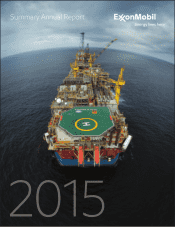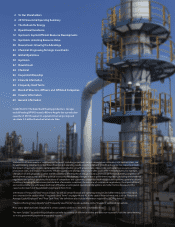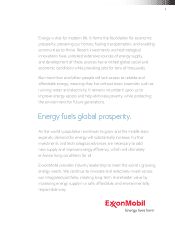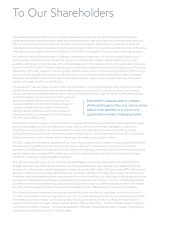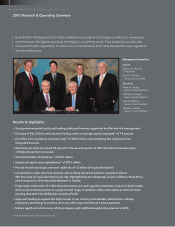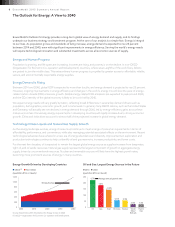Exxon 2015 Annual Report Download - page 8
Download and view the complete annual report
Please find page 8 of the 2015 Exxon annual report below. You can navigate through the pages in the report by either clicking on the pages listed below, or by using the keyword search tool below to find specific information within the annual report.
ExxonMobil’s Outlook for Energy provides a long-term global view of energy demand and supply, and its findings
underpin our business strategy and investment program. At the core of our analysis is a simple fact: Energy is integral
to our lives. As population grows and standards of living increase, energy demand is expected to rise 25 percent
between 2014 and 2040, even with significant improvements in energy efficiency. Serving the world’s energy needs
will require technological innovation and substantial investments across all economic sources of supply.
Energy and Human Progress
Population is growing, and life spans are increasing. Incomes are rising, and poverty is on the decline. In non-OECD
(Organisation for Economic Co-operation and Development) countries, where seven-eighths of the world lives, billions
are poised to join the middle class. This extraordinary human progress is propelled by greater access to affordable, reliable,
secure, and environmentally responsible energy supplies.
Energy Demand is Rising
Between 2014 and 2040, global GDP is expected to more than double, and energy demand is projected to rise 25 percent.
However, ongoing improvements in energy efficiency and changes in the world’s energy mix will slow the pace of energy-
related carbon dioxide (CO2) emissions growth. Global energy-related CO2 emissions are expected to peak around 2030,
and the CO2 intensity of the global economy is likely to be cut in half by 2040.
We expect energy needs will vary greatly by nation, reflecting broad differences in several key demand drivers such as
population, demographics, economic growth, and income levels. In general, many OECD nations, such as the United States
and Germany, will actually see net declines in energy demand through 2040, led by energy-efficiency gains across these
mature economies. Conversely, energy requirements in developing countries will rapidly increase due to strong economic
growth. China and India alone account for almost half of the projected increase in global energy demand.
Technology Drives Liquids and Natural Gas Supply Growth
As the energy landscape evolves, energy choices must continue to meet a range of consumer requirements in terms of
affordability, performance, and convenience, while also managing potential associated effects on the environment. Recent
technological advances have ushered in a new era of energy abundance and diversity. Improvements in exploration and
production technologies continue to help us identify oil and gas reservoirs, increase productivity, and lower costs.
For the next few decades, oil is expected to remain the largest global energy source as supplies increase from deepwater,
tight oil, and oil sands resources. Natural gas supply represents the largest component of growth in aggregate energy
supply, driven by unconventional resources. Nuclear and renewable sources will likely have the highest growth rates,
becoming more prominent sources of energy in many countries.
OECD(1)
Energy Savings
Energy Growth Driven by Developing Countries
(quadrillion BTUs or Quads)
1,200
1,000
800
600
400
200
0
Non-OECD
Source: ExxonMobil, 2016 The Outlook for Energy: A View to 2040
(1) OECD = Organisation for Economic Co-operation and Development.
2000 2010 2020 2030 2040
Eric Whetstone • Whetstone Design
Clark Fertitta • Investor Relations
Carol Zuber-Mallison • ZM Graphics, Inc.
studio/cell: 214-906-4162 • fax: 817-924-7784
Feb. 09, 2016
C S06A 15XOM-
.ai
2014 2040
Oil and Gas: Largest Energy Sources in the Future
(quadrillion BTUs or Quads)
250
200
150
100
50
0Oil
0.7%
Gas Coal NuclearBiomass Wind/
Solar/
Biofuels
Hydro/
Geo
Eric Whetstone • Whetstone Design
EDITOR
Clark Fertitta • Investor Relations
Exxon Mobil Corporation, Irving, TX
Carol Zuber-Mallison • ZM Graphics, Inc.
studio/cell: 214-906-4162 • fax: 817-924-7784
ATTENTION: OWNER VERSION
APPROVED BY
Jan. 22, 2016
FILE INFO
LAST FILE CHANGE MADE BY
C S06B 15XOM-
GlblDmndFuelByTyp.ai
IN F&O ON PAGE
IN SAR ON PAGE
Includes link file
1.6%
–0.2%
0.3% 2.9%
4.8% 1.3%
Average annual growth rate
The Outlook for Energy: A View to 2040
6ExxonMobil 2015 Summary Annual Report

